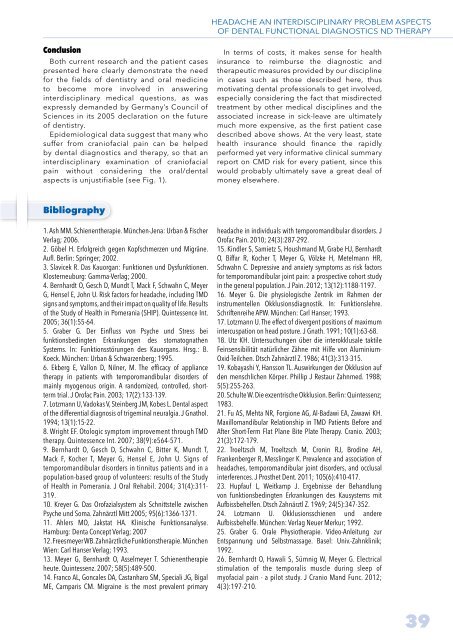STOMATOLOGY EDU JOURNAL 1-2014
You also want an ePaper? Increase the reach of your titles
YUMPU automatically turns print PDFs into web optimized ePapers that Google loves.
Headache an interdisciplinary problem Aspects<br />
of dental functional diagnostics nd therapy<br />
Figure 3. Dental<br />
risk factors for CMD<br />
are mainly occlusal<br />
interferences and/or<br />
psycho-emotional stress<br />
Figure 4. The Ahlers<br />
and Jakstat clinical<br />
summary report for<br />
CMD risk identification<br />
was extended by a test<br />
of physiological centric<br />
position<br />
from maximum occlusion in which the TMJ<br />
structures are also centered, the interplay<br />
of cusps and fissures of antagonistic teeth is<br />
characterized by the disturbance-free course<br />
of all excentric movements (Fig. 2). Receptors<br />
in the teeth, periodontium, muscles, and TMJs<br />
are connected by afferent nerves to the central<br />
nervous system, and transmit signals about the<br />
given status, e.g., the consistency and location<br />
of the to-be-chewed food near or on the teeth.<br />
Based on this sensory information, a synaptic<br />
transformation to movement follows. Along<br />
efferent nerves, the corresponding motoric<br />
units of the musculature are activated, so that all<br />
masticatory functions can run in a coordinated<br />
manner. Psychological and cortical interactions<br />
are possible (15).<br />
The mandible assumes the physiological<br />
centric relation or “zero position” to the maxilla<br />
when protractors as well as retractors are<br />
maximally relaxed, and the integral of all muscle<br />
activity is thus at the lowest level (16). In this<br />
position, maximum intercuspation is possible as<br />
long as there are no occlusal interferences. By<br />
activating the retractors, about 90% of all adults<br />
can perform a tooth-guided, ca. 1 to 3 mm<br />
mandibular retral limit movement from centric<br />
position, which was formerly known as the retral<br />
contact position and erroneously considered to<br />
be the same as centric relation (16,17).<br />
35



